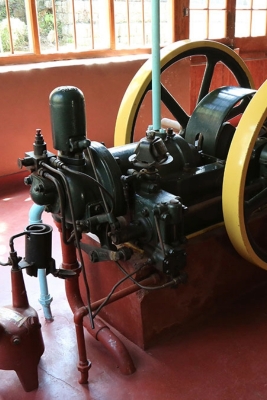Ceylon Tea Museum
a Land like no other
a Land like no other

Nestled in the lush hills of Sri Lanka’s Central Province, the Ceylon Tea Museum in Kandy is a captivating destination that takes visitors on a journey through the rich history and cultural significance of one of the world’s most famous beverages—tea. As the birthplace of Ceylon tea, Sri Lanka has a storied connection to this beloved drink, and the Ceylon Tea Museum offers an immersive experience that highlights the journey from tea plant to teacup.
Located just 3 kilometers (1.9 miles) from the heart of Kandy, the Ceylon Tea Museum is easily accessible by car, tuk-tuk, or even on foot for those who enjoy a leisurely walk. The drive from Kandy takes approximately 10 minutes, making it a perfect addition to your itinerary while exploring this culturally rich city.
For travelers coming from Colombo, the distance to the museum is approximately 110 kilometers (68 miles). The drive from Colombo usually takes around 3 to 4 hours via the A1 Colombo-Kandy road, which offers beautiful views of the surrounding hills and tea plantations. This scenic route provides a glimpse of Sri Lanka's stunning landscape, making your journey as enjoyable as the destination itself.
Perched at an elevation of around 500 meters (1,640 feet) above sea level, the Ceylon Tea Museum is surrounded by the breathtaking hills of the Kandy district. This altitude, coupled with the region's humid subtropical climate, creates ideal growing conditions for tea. The average temperature in Kandy typically ranges from 20°C to 30°C (68°F to 86°F) throughout the year, making it pleasant for visitors year-round.
The area experiences two monsoon seasons, with the southwest monsoon occurring from May to September and the northeast monsoon from December to February. These rains contribute to the lush green landscapes that are synonymous with Sri Lanka's tea country, enhancing the beauty of the museum’s surroundings.
The Ceylon Tea Museum is housed in a beautifully restored tea factory, which dates back to the early 20th century. This museum is not just about tea; it’s an educational experience that provides insight into the entire process of tea production, from cultivation to packaging. Here are some of the top attractions and experiences to enjoy during your visit:
One of the main highlights of the Ceylon Tea Museum is the tea processing exhibition, which showcases the various stages of tea production. Visitors can explore different sections of the museum that detail the journey of tea leaves, starting from their collection on tea estates to the final packaging.
The exhibition features vintage machinery and equipment used in the tea-making process, giving visitors a glimpse into the hard work and craftsmanship involved in producing Ceylon tea. Knowledgeable guides are often available to provide detailed explanations and answer any questions about the tea-making process.
The museum also offers a fascinating insight into the history of tea in Sri Lanka. Through informative displays, photographs, and artifacts, visitors can learn about the introduction of tea cultivation in the early 19th century, the impact of British colonial rule, and how Sri Lanka became one of the largest tea producers in the world.
The historical context is beautifully presented, allowing visitors to appreciate the cultural significance of tea in Sri Lankan society. This backdrop enhances the experience, making it more than just a museum visit; it’s a deep dive into the island's heritage.
No visit to the Ceylon Tea Museum would be complete without indulging in a tea tasting experience. The museum has a dedicated tea tasting area where visitors can sample various blends of Ceylon tea, each with its unique flavors and aromas. Knowledgeable staff members guide the tasting sessions, sharing insights about the different types of tea and the best brewing methods.
This sensory experience not only allows visitors to appreciate the exquisite taste of Ceylon tea but also enhances their understanding of the nuances between different tea varieties, such as black, green, and white tea.
The museum features a charming tea shop that offers a variety of Ceylon teas for sale, as well as tea-related souvenirs and gifts. Visitors can purchase their favorite blends to take home or find unique gifts for friends and family. The shop often stocks high-quality teas, ranging from classic black teas to herbal and specialty blends, making it a great spot for tea enthusiasts.
Surrounding the Ceylon Tea Museum are beautifully landscaped gardens that provide a tranquil space for visitors to relax and enjoy the breathtaking views of the Kandy hills. The gardens are filled with vibrant flowers and lush greenery, making it an ideal spot for photography or simply unwinding after your museum tour.
The museum’s elevated position allows for panoramic views of the tea plantations and the Kandy landscape, providing a picturesque backdrop that is perfect for capturing memorable moments.
When planning your visit to the Ceylon Tea Museum, consider the following itineraries to make the most of your experience:
Morning:
Mid-Morning:
Lunch:
Afternoon:
Morning:
Lunch:
Afternoon:
Late Afternoon:
The significance of tea in Sri Lanka extends beyond its delightful flavor; it plays a crucial role in the country’s economy and cultural identity. Tea production is one of the largest industries in Sri Lanka, employing hundreds of thousands of people and contributing significantly to the nation’s exports.
The Ceylon Tea Museum highlights the historical and cultural importance of tea cultivation, showcasing how it shaped the livelihoods of many families in Sri Lanka. By promoting tea tourism, the museum contributes to the ongoing appreciation and preservation of this vital aspect of Sri Lankan heritage.
2024 kandycity.org, All rights reserved | Home | Terms and Conditions | Privacy Policy | Disclaimer | Twitter | Instagram | Kandy City Guide | Contact us